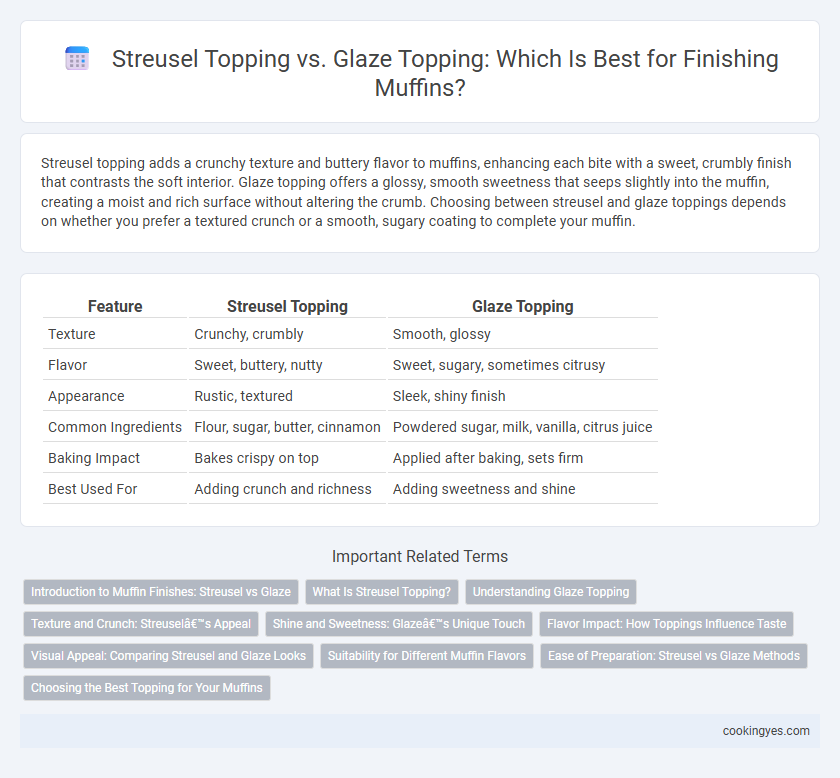Streusel topping adds a crunchy texture and buttery flavor to muffins, enhancing each bite with a sweet, crumbly finish that contrasts the soft interior. Glaze topping offers a glossy, smooth sweetness that seeps slightly into the muffin, creating a moist and rich surface without altering the crumb. Choosing between streusel and glaze toppings depends on whether you prefer a textured crunch or a smooth, sugary coating to complete your muffin.
Table of Comparison
| Feature | Streusel Topping | Glaze Topping |
|---|---|---|
| Texture | Crunchy, crumbly | Smooth, glossy |
| Flavor | Sweet, buttery, nutty | Sweet, sugary, sometimes citrusy |
| Appearance | Rustic, textured | Sleek, shiny finish |
| Common Ingredients | Flour, sugar, butter, cinnamon | Powdered sugar, milk, vanilla, citrus juice |
| Baking Impact | Bakes crispy on top | Applied after baking, sets firm |
| Best Used For | Adding crunch and richness | Adding sweetness and shine |
Introduction to Muffin Finishes: Streusel vs Glaze
Streusel topping on muffins offers a crumbly, buttery texture made from flour, sugar, and butter, providing a rich contrast to the soft muffin base. Glaze topping is typically a smooth, sweet coating of powdered sugar mixed with liquid, creating a shiny, delicate finish that enhances flavor without adding texture. Both finishes elevate muffins differently, with streusel adding crunch and glaze adding sweetness and visual appeal.
What Is Streusel Topping?
Streusel topping is a crumbly mixture made from flour, butter, sugar, and sometimes spices like cinnamon, baked on top of muffins to create a crunchy, textured finish. This topping contrasts with a glaze topping, which is typically a smooth, sugary liquid poured over muffins that hardens to form a shiny, sweet coating. Streusel enhances the muffin's flavor with added sweetness and a buttery, crispy bite.
Understanding Glaze Topping
Glaze topping for muffins creates a smooth, shiny finish that enhances both flavor and visual appeal, often made from powdered sugar mixed with liquid such as lemon juice or milk. Unlike streusel topping, which adds a crumbly, textured layer with cinnamon, nuts, and sugar, glaze penetrates the muffin's surface, providing a sweet, moist coating. Glaze toppings contribute a subtle sweetness and can be flavored in various ways, allowing for versatile muffin customization and an appealing glossy look.
Texture and Crunch: Streusel’s Appeal
Streusel topping enhances muffins with a crumbly, buttery texture that contrasts perfectly with the soft interior, offering a satisfying crunch in every bite. Its coarse sugar and cinnamon mixture caramelizes during baking, creating a crisp, golden crust that glaze toppings lack. This textural complexity makes streusel a popular choice for those seeking a rich, crunchy finish over the smooth, sometimes sticky surface of a glaze.
Shine and Sweetness: Glaze’s Unique Touch
Glaze topping offers a glossy, shiny finish that enhances the visual appeal of muffins, creating an irresistible sheen that streusel lacks. While streusel provides a crunchy, crumbly texture with a balanced sweetness, glaze delivers a more pronounced sugary flavor that intensifies the overall sweetness of the muffin. This unique touch of glaze not only elevates sweetness but also adds a smooth, attractive shine that makes muffins stand out.
Flavor Impact: How Toppings Influence Taste
Streusel topping adds a rich, buttery crunch with hints of cinnamon and brown sugar that enhance the muffin's flavor by creating a sweet, textured contrast to the soft crumb. Glaze topping offers a glossy, sweet finish that infuses the muffin with a smooth, sugary sweetness, often accentuated by vanilla or citrus notes. Each topping uniquely impacts the taste profile: streusel deepens complexity with its crunchy spices while glaze highlights the muffin's sweetness and moisture.
Visual Appeal: Comparing Streusel and Glaze Looks
Streusel topping provides a crumbly, textured finish with a golden-brown, rustic appearance that enhances the muffin's artisanal look. In contrast, glaze topping offers a smooth, shiny surface that creates a glossy, polished aesthetic, often making the muffin look more refined and inviting. Both toppings cater to different visual preferences: streusel emphasizes a hearty, homemade charm, while glaze highlights a sleek, appetizing sheen.
Suitability for Different Muffin Flavors
Streusel topping with its crumbly, buttery texture enhances dense, fruit-based muffins like blueberry or apple cinnamon by adding contrast and sweetness. Glaze topping provides a smooth, glossy finish ideal for lighter, citrus or vanilla-flavored muffins, imparting a subtle sweetness without overpowering the delicate taste. Choosing the right topping depends on the muffin's flavor profile, where streusel suits hearty, textured muffins, and glaze complements airy, mild varieties.
Ease of Preparation: Streusel vs Glaze Methods
Streusel topping for muffins requires a mixture of flour, sugar, and butter, which is crumbly but simple to prepare, often needing only basic mixing before sprinkling on batter. Glaze topping typically involves dissolving powdered sugar in liquid such as milk or lemon juice, resulting in a quick, smooth finish applied after baking. Streusel demands slightly more effort due to texture balance, while glaze offers ease with minimal steps and ingredients.
Choosing the Best Topping for Your Muffins
Streusel topping offers a crumbly, buttery texture with a blend of cinnamon and sugar that enhances muffins with added crunch and sweetness. Glaze topping provides a smooth, glossy finish that can be flavored with vanilla, lemon, or maple, delivering a delicate sweetness and moisture boost. Choosing between streusel and glaze depends on whether you prefer a textured, richer finish or a lighter, sweet coating to complement your muffin's flavor.
Streusel topping vs Glaze topping for muffin finish Infographic

 cookingyes.com
cookingyes.com